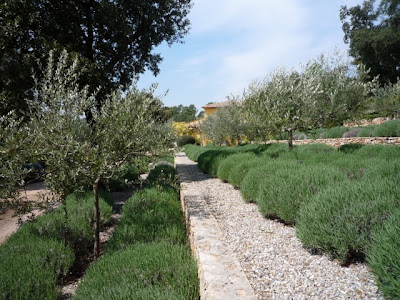On 27th March 2012 our garden group visited Sally Perigo’s garden in Lorgues. Sally is a well known garden designer in the area. We had asked her if she could do a presentation on garden design. The following are some of the principles she mentioned:
Take your time, don't be in a hurry – when you’ve bought a property, the best thing is to take your time. With an existing garden, before you start changes things it may be a good idea to see what plants come up during the first year. After the first year you'll have had time to reflect on what you would like to keep and what needs to be changed.
The garden of a new property is a blank canvas, perhaps there are trees which can be used as focal points but, as with the existing garden, do not rush into things.
Take into account the size of the garden in relation to the house. Make a list of what you would like to have in your garden i.e. practical and structural issues, and at the very last, what plants you would like. When a garden is well designed, you may not necessarily notice it, but if it's not well designed you definitely notice - it jars.

Planning stage - The most expensive part of the garden is the hard landscaping. If you make a mistake it is very costly to change. Automatic watering system, pipe work and electricity cables for lighting, automatic gates, pool equipment, etc. all have to be thought of during the preliminary stages. The terrain in the Var is very rocky and stony and consequently in most cases the soil is, at best, poor and, at worst, negligible. Be prepared to buy in earth from a good source.
If the house has a view of any description, avoid planting trees around it. Trees should not be planted near the house or pool as because the roots will cause problems to any terraces that may be laid, and even to the foundations of the house. The general rule is that the tree should be planted 1 & 1/2 times it's final height away from the house. Pencil cypresses are architectural and can be used to frame a doorway, gates, arch, feature etc.
If you have a steep bank, create terraces with the highest plants at the back and shortest in front so that one does not obscure the other.

Composition - basically a garden is made up of hard and soft landscaping with voids (all low laying features like, swimming pools, lawns, terraces) and masses (plants, pergolas, furniture ). The ratio should be 1/3rd mass to 2/3rd void.
Pool – avoid planting trees or shrubs which drop leaves close to the pool.
Seating areas - make a note where the shade is at various times of the day in the areas you are thinking of putting table and chairs (this will change in summer when the sun is higher).
Terraces - ensure that terraces are deep enough to allow guests to pull back their chair to sit down at the dining table and to move behind chairs when people are seated; and that they offer adequate shade from the summer sun. Make sure surfaces are non-slip near the pool and when it is raining.
Paths - should be wide enough for two persons to walk next to each other. If you have a straight path make sure it has a focal point (statue, large olive jar planted with citrus tree or olive, an exit to a field or view beyond) so that the eye is connected to the focal point otherwise it will be a dead end!
Steps - if you are to put steps leading to a terrace for example make sure the steps are in proportion and not just something stuck on the side as an afterthought.

Planting - choose plants/trees that are drought resistant (after the initial first season watering) and frost tolerant to -12C and be aware that coastal garden centres may not stock frost hardy plants.
Repeat planting with a repetition of plants, shapes and forms is more effective than a garden full of different plants. Keep uniform shapes and sizes next to each other to avoid the "little and large effect" ! Different leaf textures and greens are just as interesting as flowering plant.
Terraces of lavender against stone walls, for example, are evocative of Provence but lavender may need replacing every 5 years when it can become too leggy and woody Plant in three’s or odd numbers. Plant in two’s only as a focal point, e.g. either side of a door.

When choosing colours, purple and blues planted at the end of a garden make the garden look longer, red and orange colours shorten a perspective. All pale or subtle colours appear white at a distance so choose strong colours for plants viewed from far away.
In the colour spectrum, any colour that lies next to the colour green (such as blue and yellow) is in harmony. For instance, the colour red on the colour spectrum comes after yellow and orange and is further away from the colour green so when planted together, it creates a contrast. Colours that are next to each other on the spectrum go well together.
For further details on Sally's garden design, please contact the following websites:
This blog is a joined effort by Diana H., Sue S. and Saskia

No comments:
Post a Comment